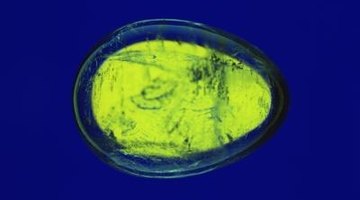How to Identify Gel Blobs Found in Ponds
Gel blobs often form in damp, warm environments, making a backyard pond the ideal location for a host of gel formations. While your first thought may be to claim blobs as bacteria, look closer. Gel blobs that form in water are not always fungus or bacteria and could contain tadpole eggs. Make the correct identification by understanding the differences between fungi, bacteria and spawning.

-
Look at the gel blob closely. If you find a dark spot in the middle of the blob, you are looking at an amphibian egg sac such as an unhatched tadpole. Many amphibians lay eggs in a gelatinous sac to protect the unborn fetus inside. If there is no spot in the middle of the gel, it's likely not an egg sac.
-
Determine the location of the gel blobs. Pond slime can rise to the surface of your pond and form a thick coating as the blobs stick together, while bacteria or egg sacs float freely just below the surface of the water.
-
Note the color of the gel. Clear gels commonly indicate a product of fish or amphibian mating, while green or yellow globules indicate bacteria or fungal invasions. Dead plant matter can also form green or yellow globules that float freely through your pond water.
-
Collect a sample of the gel matter and take it to a university science department. By looking at the sample under a microscope, science students or professors can determine whether the gel is bacterial or fungal and what class it belongs to by identifying its shape and makeup.
References
Writer Bio
Sharin Griffin has been a freelance writer since 2009, specializing in health-related articles. She has worked in the health-care industry as a certified nursing assistant and medical technician. Griffin's medical expertise encompasses bariatrics and geriatric care, with an emphasis on general medicine. She is completing an associate degree in health-care administration from Axia University.
Photo Credits
- Jupiterimages/Creatas/Getty Images
More Articles



